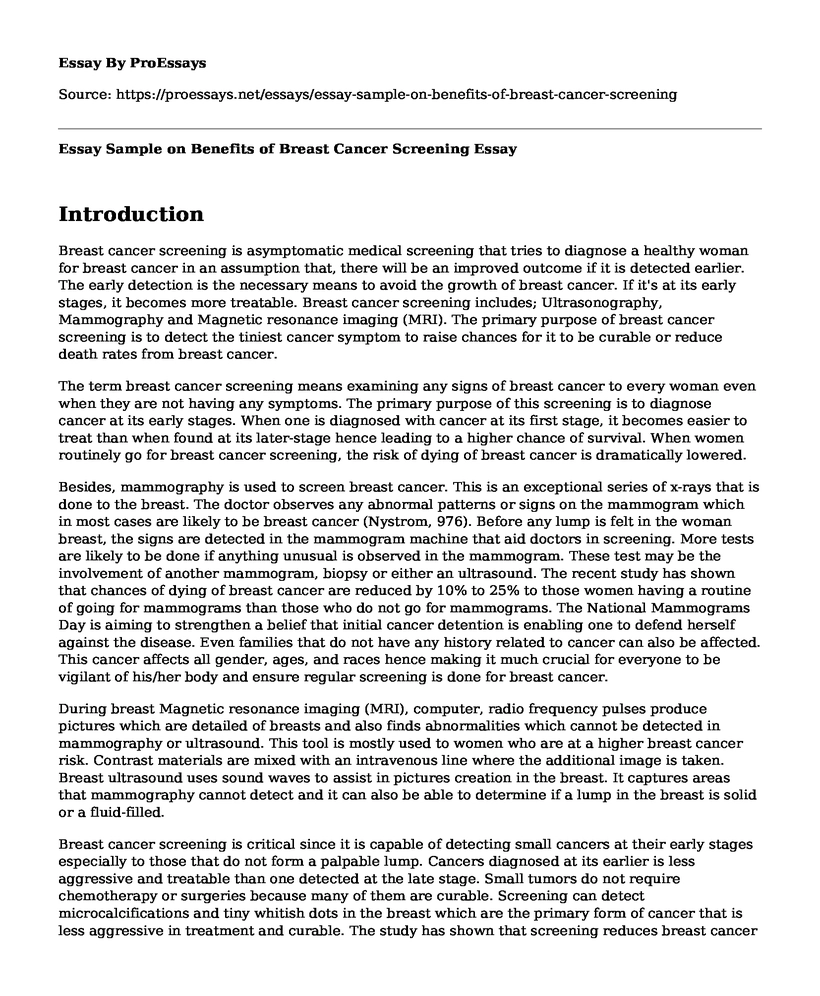Introduction
Breast cancer screening is asymptomatic medical screening that tries to diagnose a healthy woman for breast cancer in an assumption that, there will be an improved outcome if it is detected earlier. The early detection is the necessary means to avoid the growth of breast cancer. If it's at its early stages, it becomes more treatable. Breast cancer screening includes; Ultrasonography, Mammography and Magnetic resonance imaging (MRI). The primary purpose of breast cancer screening is to detect the tiniest cancer symptom to raise chances for it to be curable or reduce death rates from breast cancer.
The term breast cancer screening means examining any signs of breast cancer to every woman even when they are not having any symptoms. The primary purpose of this screening is to diagnose cancer at its early stages. When one is diagnosed with cancer at its first stage, it becomes easier to treat than when found at its later-stage hence leading to a higher chance of survival. When women routinely go for breast cancer screening, the risk of dying of breast cancer is dramatically lowered.
Besides, mammography is used to screen breast cancer. This is an exceptional series of x-rays that is done to the breast. The doctor observes any abnormal patterns or signs on the mammogram which in most cases are likely to be breast cancer (Nystrom, 976). Before any lump is felt in the woman breast, the signs are detected in the mammogram machine that aid doctors in screening. More tests are likely to be done if anything unusual is observed in the mammogram. These test may be the involvement of another mammogram, biopsy or either an ultrasound. The recent study has shown that chances of dying of breast cancer are reduced by 10% to 25% to those women having a routine of going for mammograms than those who do not go for mammograms. The National Mammograms Day is aiming to strengthen a belief that initial cancer detention is enabling one to defend herself against the disease. Even families that do not have any history related to cancer can also be affected. This cancer affects all gender, ages, and races hence making it much crucial for everyone to be vigilant of his/her body and ensure regular screening is done for breast cancer.
During breast Magnetic resonance imaging (MRI), computer, radio frequency pulses produce pictures which are detailed of breasts and also finds abnormalities which cannot be detected in mammography or ultrasound. This tool is mostly used to women who are at a higher breast cancer risk. Contrast materials are mixed with an intravenous line where the additional image is taken. Breast ultrasound uses sound waves to assist in pictures creation in the breast. It captures areas that mammography cannot detect and it can also be able to determine if a lump in the breast is solid or a fluid-filled.
Breast cancer screening is critical since it is capable of detecting small cancers at their early stages especially to those that do not form a palpable lump. Cancers diagnosed at its earlier is less aggressive and treatable than one detected at the late stage. Small tumors do not require chemotherapy or surgeries because many of them are curable. Screening can detect microcalcifications and tiny whitish dots in the breast which are the primary form of cancer that is less aggressive in treatment and curable. The study has shown that screening reduces breast cancer mortality up to 30%.
Conclusion
In conclusion, breast cancer screening is asymptomatic medical screening that tries to diagnose a healthy woman for breast cancer in the assumption that, there will be an improved outcome if it is detected earlier. Testing is essential since it is capable of detecting microscopic tumors at their early stages especially to those that do not form a palpable lump. Cancers diagnosed at its earlier is less aggressive and treatable than one detected at the late stage. Small tumors do not require chemotherapy or surgeries because many of them are curable.
Works Cited
Nystrom, L., et al. "Breast cancer screening with mammography: Overview of Swedish randomised trials." The Lancet 341.8851 (1993): 973-978.
Cite this page
Essay Sample on Benefits of Breast Cancer Screening. (2022, Nov 01). Retrieved from https://proessays.net/essays/essay-sample-on-benefits-of-breast-cancer-screening
If you are the original author of this essay and no longer wish to have it published on the ProEssays website, please click below to request its removal:
- Nursing Scholarship Application Letter
- How a Nurse Does Learn How to Be a Nurse?
- Essay Example on Opiates and Opioids: Pain-Relieving Drugs With Similar Effects
- Essay Sample on Breast Cancer: Early Detection and Awareness for Women's Health
- A Dream Come True - Becoming a Psychiatric Nurse Practitioner - Essay Sample
- Paper Example on Hospital-Acquired Pressure Ulcers: Causes & Risk Factors
- Paper Example on Designing Facilities for Optimal Healthcare: Stakeholder Perspectives







